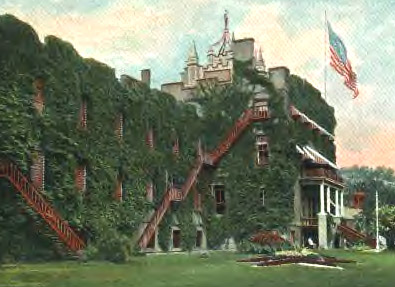 i i |
[Image selection & caption by NYCHS webmaster] |
|
between Auburn Theological Seminary & Auburn State Prison ©
The two most impressive building projects in the Village of Auburn during the early days of the 19th century were erected for contrary
purposes. Fortunately early on a common bond of faith was established between the two institutions when the builder of the prison, a firm believer in
religion, came to the assistance of the founder of the seminary. The meeting took place at noon on the day ground was broken for the
seminary, Tuesday, November 30, 1819.
To fully understand the importance of the connection established between the seminary and the prison on that day, a brief review of several
events which had preceeded the occasion must be examined-before continuing this story.
It is a matter of record in the archives maintained by the Cayuga County Historical Society that on February 20, 1792, Colonel John Hardenbergh , a veteran of the Revolutionary War, purchased Lot #47 in the military tract. He came into the Township of Aurelius in 1793 and
took possession of his farm which bordered on the banks of the Owasco Lake Outlet. As soon as
possible after becoming settled in his home he had a dam and a grist mill built on the nearby river. The erection of the
mill was the great event which helped to build the settlement.
The direct result of the operation of the mill was an accumulation of settlers near the junction of two roads there which
for a time was called, Hardenburgh Corners. Soon every road was choked with emigrants to the area. By and large
the heritage of Aurelius and Cayuga County of which it was a part was that of Calvinist New England. Calvinism
provided settlers with a basis for the creeds of Presbyterian and Reformed Protestant religions.
The above description of Auburn Village from the 1813 Gazetteer of New York mentions houses, the courthouse and county jail, stores, manufactories and mills as well as the lake and "a fine stream with falls."
The state prison and theological school were then still years away in Auburn's future.
For a list of image links to a larger version of this and other Auburn views, visit Bill Hecht's excellent site of old maps, pictures, postcards, air photos, and geology info for Cayuga County and the Finger Lakes. [Image selection & caption by NYCHS webmaster]
Many settlers were sober, middle class people of agricultural stock. They had been pushed out of New England by
adverse economic conditions. They brought with them a desire for civilization, refinement, and law and order.
Additionally they sought to establish churches, schools and other institutions which would help to nourish a stable
culture.
In June, 1803, Hardenburgh Corners was given the shorter and more euphonious name of "Auburn". The place had
been designated as the county seat and a more dignified name was desired. The population of the surrounding area of
Cayuga County had increased to over 16,000 residents and was now a very active business place.
Auburn was legally incorporated as a village by the State Legislature on April 18, 1815. Auburn then contained about
200 buildings and had 1,000 inhabitants.
The first board of trustees sought help from the State Legislature for a new industry that would confer importance
and create prosperity in the village.
For some years the Legislature had been considering a proposition to build a prison in western New York. The people of Auburn wanted to
have the prison built in the villager believing that it would stimulate business as well as promote land sales. Local citizens offered to donate
land beside the Owasco River as a site for the institution. Their offer was accepted and on June 18, 1816, the southeast cornerstone of the
wall was laid. Auburn was going to be in the -prison business.
The Auburn Theological Seminary, a school of higher education: for the preparation of candidates for the ministery of the Presbyterian church,
was established by the Synod of Geneva in 1819. The seat of the institution was fixed at Auburn as a result of liberal contributions towards its
endowment by several local citizens.
|

